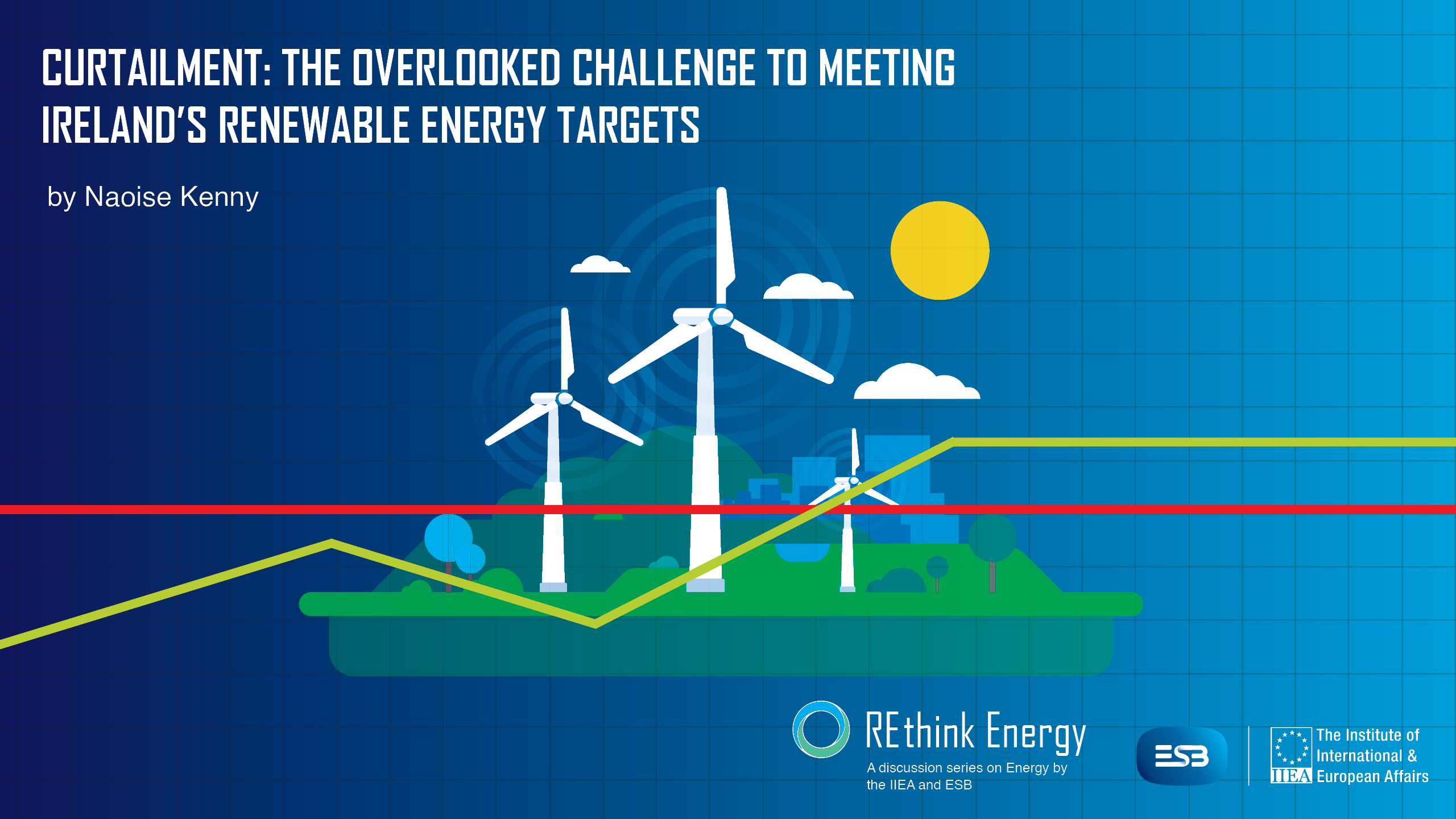Curtailment: The overlooked challenge to meeting Ireland’s renewable energy targets

Executive summary
On Wednesday, 14 June 2023, Emeritus Professor and Director of the Energy Policy Research Group at the University of Cambridge, David Newbery, delivered an address titled Electricity in Ireland: Transition and the energy sector, in the first installment of the 2023 REthink Energy lecture series, co-organised by the IIEA and ESB. Professor Newbery’s address examined a wide array of issues relating to the electricity sector, but the central problem under discussion was that of ‘curtailment’ - the level of surplus renewable energy that is wasted in Ireland.
The Irish Government has set the ambitious target of having 50% of Ireland’s energy met by renewable sources by 2025, and 80% by 2030, meaning that a vast amount of wind and solar capacity must be added to Ireland’s electricity grid over the course of the next number of years. Professor Newbery argued that, as the share of renewable energy rises, so too will the amount of wasted or surplus energy that is generated, because the threshold of how much renewable electricity the system can accommodate will increasingly be surpassed. This wastage is known as ‘curtailment’ and, according to Professor Newbery, it is an underappreciated consequence of high renewable penetration, and is a problem that is particularly relevant to the Irish market.
If the level of curtailment increases, so too will the relative cost of generating electricity, as will the cost of displacing carbon, which could defeat the purpose of adding renewable sources of energy such as from solar or wind to the grid in the first place. Professor Newbery suggested that, if nothing is done, curtailment may be as high as 50% in some cases, which means that the marginal cost of generating electricity would double.
According to Professor Newbery, it is imperative, therefore, that we take steps to reduce curtailment, as we add renewable capacity to the grid. Currently, only 75% of Ireland’s electricity demand at any one time can be met through the use of renewables, which is known as the system non-synchronous penetration (SNSP) limit. Professor Newbery argued that if serious problems with curtailment are to be avoided, we must raise the SNSP limit to 95% by 2030.
According to Professor Newbery, reducing curtailment by increasing the SNSP limit can be achieved in a number of ways, including through the development of interconnectors, which would allow excess electricity to be exported; by the development of battery storage; by increasing the efficiency of Ireland’s transmission network; and via the adoption of demand-side management measures to reduce peak demand.
Key takeaways
The problem
Professor Newbery shed light on what he sees as the often overlooked challenge of meeting Ireland’s renewable energy targets: curtailment. He explained that, as more renewable capacity is added to Ireland’s grid, the amount of curtailed – or wasted – energy will also increase. With the ambitious target of having 80% of Ireland’s electricity demand met by using renewable sources by 2030, the issue of curtailment is a serious challenge for the Irish market. The result of increased curtailment will be the increased cost of electricity generation (in some cases, this will double) and the untenably high cost of carbon displacement, which could defeat the purpose of adding renewables to the grid.
The objective
Curtailment occurs with ‘non-synchronous’ renewable sources, which provide more electricity at certain times than they do at others. This means that, at times of peak output for wind and solar, much of the electricity being generated goes to waste. At the moment, the system non-synchronous (SNSP) limit in Ireland is at 75% of demand, meaning that any renewable electricity generated above this cut-off point is wasted. If serious issues are to be avoided, the SNSP limit must be raised to 95% by 2030.
The solution
There are a number of ways in which the SNSP limit can be increased to meet the 95% target and sufficiently reduce curtailment. The measures required to achieve this goal and ultimately, to make Ireland’s 2030 renewable electricity targets viable, include:
- Developing our interconnector network with France and Great Britain. This would allow surplus energy to be exported from, or imported to, the island of Ireland, thereby reducing wastage.
- Increasing the capacity for battery storage. By trebling battery storage capacity, we can offset curtailment by storing electricity for a number of hours and redeploying it at off-peak times. Unfortunately, the development of green hydrogen technologies, which is the only viable option for long-term storage, is extremely expensive and inefficient at the current time.
- Increasing transmission efficiency. By strategically locating new transmission infrastructure, the Single Electricity Market (SEM) can avoid delays and transmission inefficiencies, which will help to reduce curtailment.
- Demand-side management. By implementing demand-side management measures, we can reduce peak demand and spread usage more evenly throughout the day. This will assist in reducing the level of wasted electricity at peak times.
- Passing on the benefits of low-cost renewables to consumers. Incentivising the use of renewables through pricing mechanisms, while ensuring consumers are also incentivised to economise on their electricity usage, will help secure the long-term future of the renewables market in Ireland.
